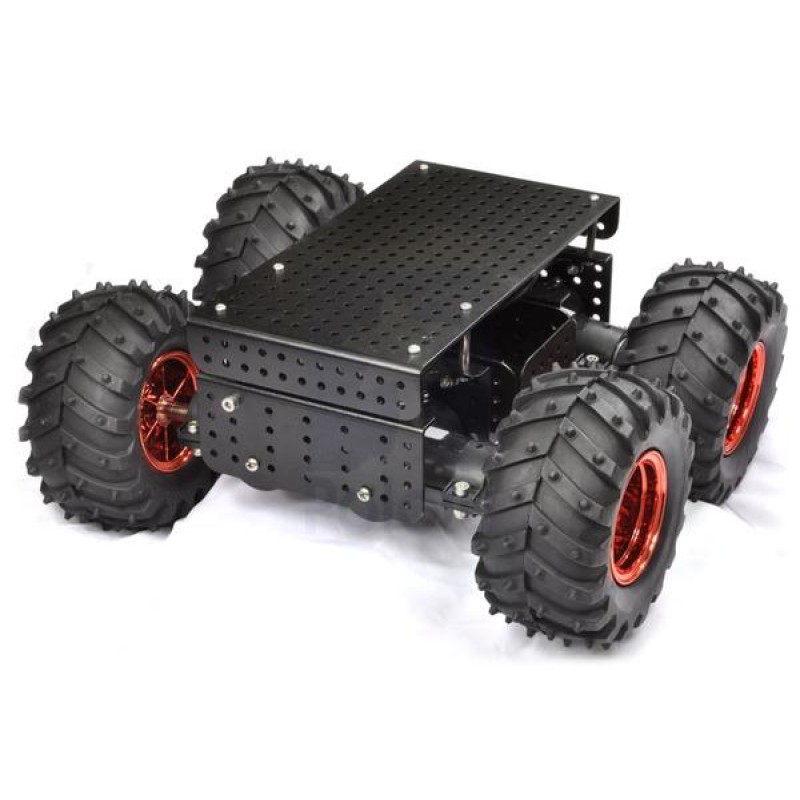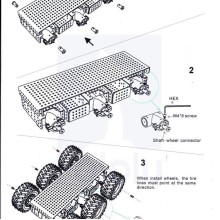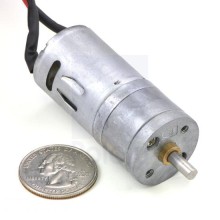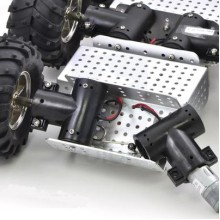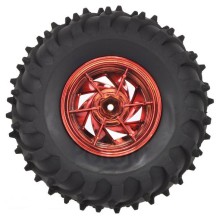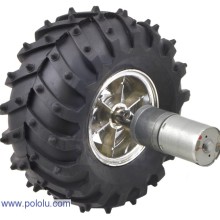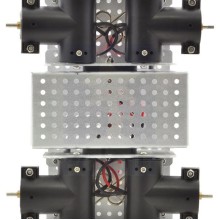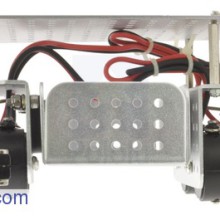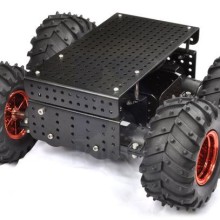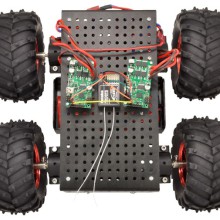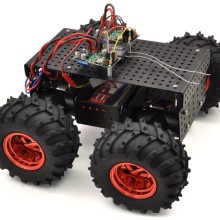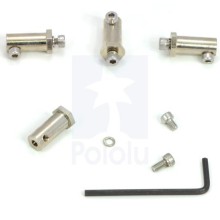Dagu Wild Thumper 4WD All-Terrain Chassis, Black, 34:1
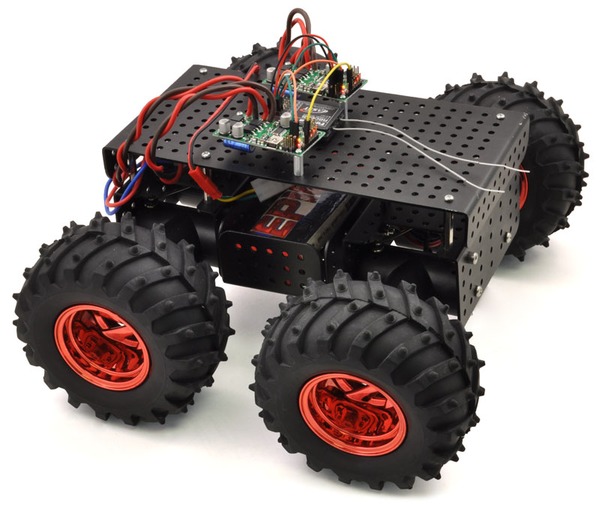
This rugged, 4-wheel-drive chassis from Dagu Electronics is a smaller version of the Wild Thumper 6WD chassis.
It is designed to excel at traversing rough terrain, making it a great platform for any robot that needs to perform tasks in a complex outdoor environment.
It features four powerful DC motors with brass brushes and 34:1 or 75:1 steel gearboxes that drive large (120mm diameter) spiked tires, and a unique “super-twist” suspension system acts to keep each wheel in contact with the ground for maximum traction, even when driving over uneven or bumpy surfaces.
The suspension can be adjusted to suit different loads and conditions.
The chassis is made from a 2mm-thick corrosion-resistant anodized aluminum plate, all of the nuts, bolts, and screws are stainless steel, and the brass fittings and suspension springs are nickel-plated.
When powered at 7.2V, the version of the chassis with 34:1 gearboxes can reach a top speed of approximately 7km/h (4.5mph), and each motor has a stall torque of roughly 5kg-cm (70oz-in). At the same voltage, the version of the chassis with 75:1 gearboxes can reach a top speed of approximately 3km/h (2mph), and each motor has a stall torque of roughly 11kg-cm (150oz-in).
Using the Chassis
The chassis’ aluminum plate has 4mm holes spaced every 10mm, providing plenty of options when it comes to mounting your control electronics, sensors, and additional hardware.
A compartment in the chassis has been designed to hold 7.2V sub-C battery packs (not included) that are commonly used in RC cars. Two such battery packs can fit in the compartment.
The interior of the chassis also features convenient screw terminals for connecting your battery and motor driver leads. The motor leads are pre-connected to these screw terminals.

| Gear ratio: | 34:1 |
|---|---|
| Color: | black |
This is a differential-drive chassis, meaning that turning is accomplished by driving the motors on the two sides of the platform at different speeds. The two motors on each side of the robot are wired in parallel, so only two channels of motor control are required to get this chassis moving. The motors are intended for a maximum nominal operating voltage of 7.2V (2V minimum), and each has a stall current of 6.6A and a no-load current of 420mA at 7.2V. Since the motors will briefly draw the full stall current when abruptly starting from rest (and nearly twice the stall current when abruptly going from full speed in one direction to full speed in the other), we recommend a motor driver capable of supplying the 14A combined per-channel stall current of these motors at 7.2V. We offer several motor controllers that meet these power requirements and make it easy to get this chassis moving:
- The Simple High-Power Motor Controllers offer a variety of control interfaces: USB, TTL serial, analog voltage (for control from a potentiometer or analog joystick), and RC hobby servo pulses. These controllers are highly configurable and the USB interface makes them very easy to set up and use. Since the SMC is a single-channel controller, you would need to use two with the Wild Thumper, one for each side of the chassis.
- The qik 2s12v10 dual serial motor controller provides a simple serial interface and offers features such as acceleration control and current limiting. This is a dual motor controller, so a single unit can independently control the two sides of the chassis.
- The TReX dual motor controller offers an RC interface for human control (it can act as a simple ESC right out of the box) and a serial interface for autonomous operation, and it features the ability to blend the two to make a robot that can optionally respond to RC control. Like the qik, the TReX is a dual motor controller, so you can control the chassis with a single unit.
- The dual VNH5019 motor driver shield for Arduino is easy to control with an Arduino, and it can also be used with other microcontroller boards as a general-purpose dual motor driver. Since this is just a driver, it lacks many of the advanced features of the motor controllers listed above (like built-in acceleration limiting or high-level interfaces such as USB and RC), but such features might not be necessary if your goal is to make a basic autonomous robot.
- The programmable Orangutan X2 robot controller can be the entire control center of an autonomous robot based on this chassis.
Specifications
- Size: 280 × 300 × 130 mm (11" × 12" × 5")
- Weight: 1.9kg (4.1lb)
- Ground clearance: 60mm (2.5") when lightly loaded
- Recommended motor voltage: 2 – 7.5V
- Stall current at 7.2V: 6.6A per motor
- No-load current at 7.2V: 420mA per motor
-
No-load output shaft speed at 7.2V:
- 350RPM for the version with 34:1 gearboxes
- 160RPM for the version with 75:1 gearboxes
-
Stall torque at 7.2V:
- 5kg-cm (70oz-in) per motor for the version with 34:1 gearboxes
- 11kg-cm (160oz-in) per motor for the version with 75:1 gearboxes

